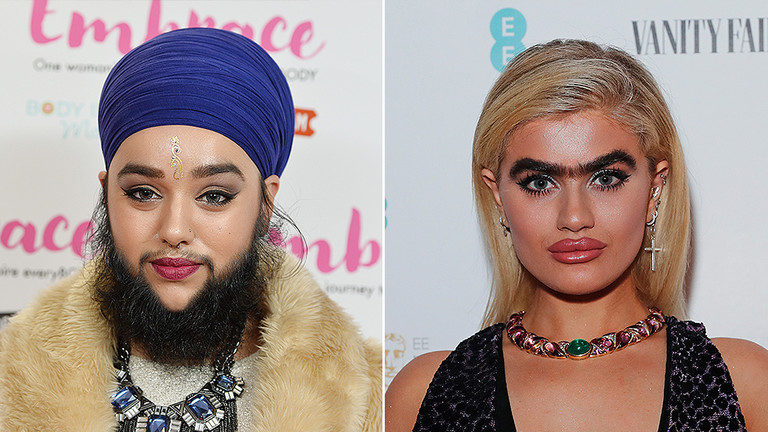
The 'self-love' issue features cover stars including Sophia Hadjipanteli, owner of distinctively bushy eyebrows and founder of #UnibrowMovement, which "shook up traditional beauty standards," Chidera Eggerue, who kickstarted the #SaggyBoobsMatter campaign after years of lamenting the shape and size of her boobs and Harnaam Kaur, who, at the age of 16 became the youngest woman in the world to have a full beard. Having grown up with polycystic ovary syndrome that led to a growth of facial hair, she "defied bullies and committed to embracing her natural appearance," the magazine writes.
The message from the women is clear. 'Say no to being policed from head to toe with how we should look or what we should be doing with our bodies.' The 'Westernised standards of beauty,' which have forced women to want to be thin and pretty need to be put to bed once and for all, even if the images are photoshopped and post processed to make them look more aesthetically pleasing.
The ironic thing is that magazines like Glamour have set these beauty standards for the past decades, not society as a whole.
Women have fallen prey to the ideals set out by magazines, Hollywood and size zero celebrities. According to the American Society of Plastic surgeons, Americans alone spent over $16.5 billion on cosmetic plastic surgery and minimally-invasive procedures in 2018. With breast augmentation and liposuction, tummy tucks and nose reshaping being most popular. Over 90 percent of procedures are made on women.
It's the exploitative media industry that has relentlessly targeted females, first telling them that tanned is good, slim is good, fitness is good, pretty is good. But now the "white supremacist beauty ideal" has been replaced with another beauty ideal, the body positive movement, and the message has changed.
Or has it?
Magazines are essentially doing the same as they were before: selling copies or getting payment for placements and ads by focusing on women's appearances, whatever they may be.
They just want to be more in touch with woke times, so they've generated a notion that indeed white beauty ideals need to be taken to task.
Perhaps this is why the issue included Munroe Bergdorf, a Brtiish trans model and campaigner for transgender rights.
You may recall her from the time she said all white people were racist on the UK's Channel 4 News and was dropped from L'Oreal as a result, just three days into her contract.
"Your entire existence is drenched in racism," she said in response to the Charlottesville riots in 2017.
Double standards prevail
The same movement that celebrates 'body positivity,' shames the likes of singer Adele, who was recently photographed looking too slim for some people's liking.
Yet, Stephanie Yeboah, the thirty-year-old founder of the Nerd About Town blog and plus-sized model, made the list as a prominent voice of the body-confidence movement and author of Fattily Ever After: The Fat, Black Girls' Guide to Living Life Unapologetically. Her obesity is given a platform, while those who are apparently too thin under the 'new beauty' standards are vilified. But being overweight and being underweight are two sides of the pendulum, and if the magazine was truly balanced it could also feature an anorexic girl.
Women and leading females in the media are all about looks and if you're not with them, you're a fat-shamer, trans-shamer, beard-shamer, or whatever.
Vulnerable women beware, these magazines aren't charitable organisations, they are businesses and want your money. Glamour - which shifted from being a printed publication to an online-only one in 2019 - has recognized that the victim narrative is big and wants to cash in on it.
They are perpetuating a culture of victimhood, which, coupled with social media is not just bad for women, but society as a whole.
Beauty standards have been a certain way since Coco Chanel first discovered the suntan, or Twiggy the stick arms. So why are these "new faces of beauty" being put on a pedestal now?
Does it really have nothing to do with pandering to body positivity trends?
Humanity has come a long way since King Leopold II imported 267 Congolese to Belgium in 1897, putting them on canoes and letting them paddle around the royal lakes in his colonial palace, as millions of visitors looked on.
We celebrate people regardless of ethnic background, physical norms or the colour of their skin and yet vulnerable people are still being put on display because of their appearance, the colour of their skin, or the way they look.
Glamour you aren't being radical, you are doing what you've always done, made it about looks.
If you want to be real, why not make it about merit?
Barbara McCarthy is a freelance commentator, photo-journalist and travel writer based in Dublin. She contributes regularly to The Irish Independent, The Irish Times, RT.com, The Sunday Times and others. Follow her on Twitter @BarbsMcCarthy



Reader Comments
Get Woke;
Go Broke.
Don't Be Mistaken;
Instead, Awaken.
RC
My favorite dogs are those ones with the pushed-in faces.
They have a variety of health issues that respond to treatment. This is very exciting to watch.
The worst dogs in the world are those which interbreed freely and without predestination in mind. Those who do not follow the rules of modern and proper intercourse.
These mutts cannot be helped and are therefore of no account.
One sees them on the street sometimes, without a leash.
We cannot let nature rule our dog world. We cannot operate without a license.
We must select only the best.
Time will tell all.
signed,
dog lover